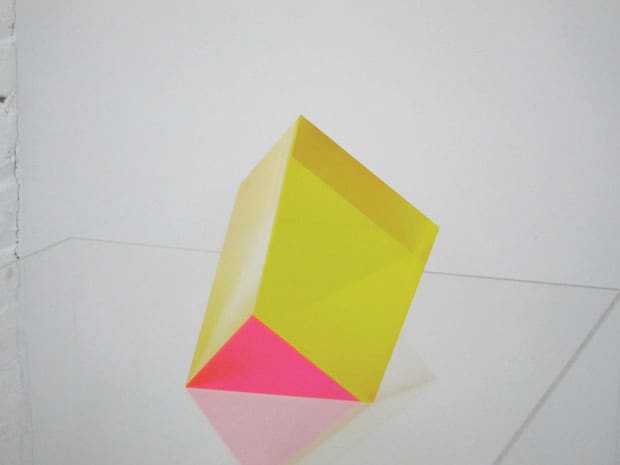If you’ve ever been so in love with a color that you want to capture its vibration and live inside it forever, than you would probably understand the work of Phillip Low. His prismatic, acrylic sculptures are large enough to get lost in, but small enough to hold, like some magic sci-fi fantasy crystal you’ve stolen away, its secrets revealed only to you. Ranging in size from about six to twelve inches, the polyhedral objects play with form, color and light, the combination of which seems to stir the existential, simultaneously evoking the childlike wonder of a bright, shiny thing, and the adult depth of knowing there will be murky areas in between. It’s not hyperbole—some serious thinkers (Goethe!) have considered prisms very worthy objects to ponder.
But technically you can’t call Low’s sculptures prisms because the geometry is imprecise and the surface is muted. Instead of color radiating from the bending of light through facets, Low fuses together colored and clear acrylic to create his spectrums. “I have limitations with size, due to [the capability of] my tools,” he explains, “but I want the work to be malleable. If you have this big thing then you lose that immediacy, that intimacy of wanting to move it around. It becomes this monument and doesn’t have that sort of sweetness,” he laughs,
adding ironically, “like Jell-O.”
Low trained as a fashion designer at the prestigious Central Saint Martins, but says that his degree collection was all about two-dimensional architecture and design. “That was my focus at school. And my jewelry at the show was chunks of plexiglass.” These early inklings were prophetic, and Low has even further disassociated himself from fashion. “It’s just not my world. I don’t care about clothes anymore, as you can see,” he says, motioning to the day’s uniform of a navy Champion sweatshirt and loose-fitting jeans.
Low spent the last 15 years buying and collecting acrylics, resins and light and space art pieces from the ’50s, ’60s and ’70s, and he says his work today is particularly indebted to artist Vasa Mihich. “It was about 16 years ago that I found a piece of his work in a flea market that he had made in like ’74, and it was an epiphany.” But where Mihich’s work explores color interaction through, crisp, high-gloss geometric form and theory (think Pink Floyd’s iconic light and dark spectra logo), Low deals in gradation and subtlety. He’s more interested in the color’s emotion than its science. Low’s first acrylic works were also glossy, but he didn’t like that the finish scratched easily and felt unapproachable. To combat this, he started treating the surface so that it would have an almost a striated effect. This textured surface makes the objects more tactile; you’re unafraid to leave a fingerprint. Which is precisely the point.
